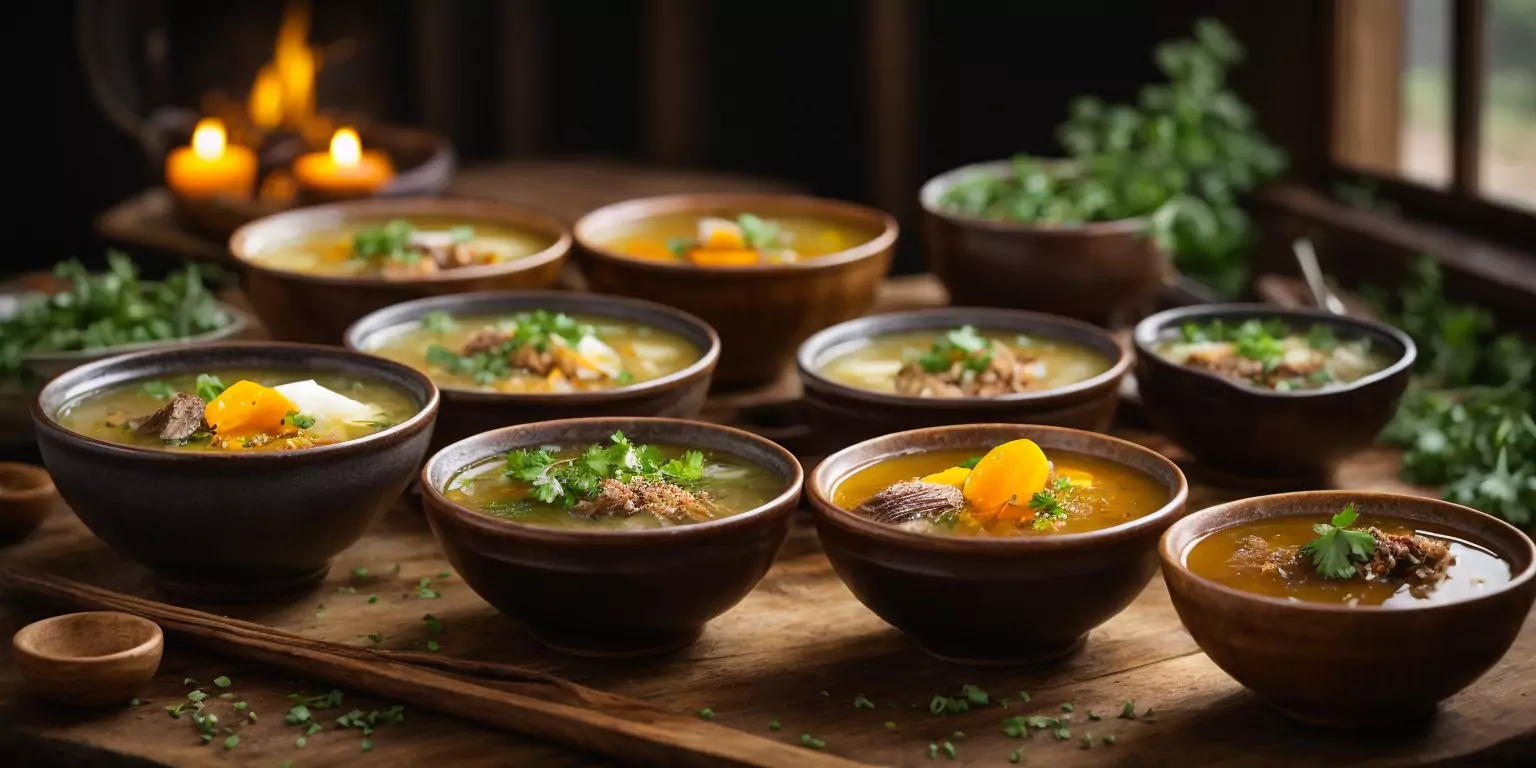Bone broth is a game-changer. It’s not just a simple recipe; it’s a great one! The beauty lies in its simplicity, making it the go-to for many home cooks. Whether you’re simmering chicken bones, mixed beef bones, or both in a crockpot, bone broth adds depth and flavor effortlessly. Plus, crafting your own batch requires minimal effort but yields maximum benefits – both for your taste buds and overall health. Ready to elevate your cooking with this easy bone broth recipe? Let’s dive into the basics of delicious homemade food and unlock its potential.
- 5 Easy Bone Broth Recipes
- Selecting the Best Bones for Flavorful Broth
- Essential Ingredients for Homemade Bone Broth
- Bone Broth Making Methods: Stove, Instant Pot, and Crock Pot
- Tips for Perfect Bone Broth Every Time
- Flavor Enhancements and Customization Options
- Incorporating Bone Broth into Daily Meals
- Storing and Reheating Your Homemade Bone Broth
- Understanding the Health Benefits of Regular Consumption
- Conclusion on Mastering Easy Bone Broth Recipes
- Frequently Asked Questions
5 Easy Bone Broth Recipes
Classic Chicken Bone Broth
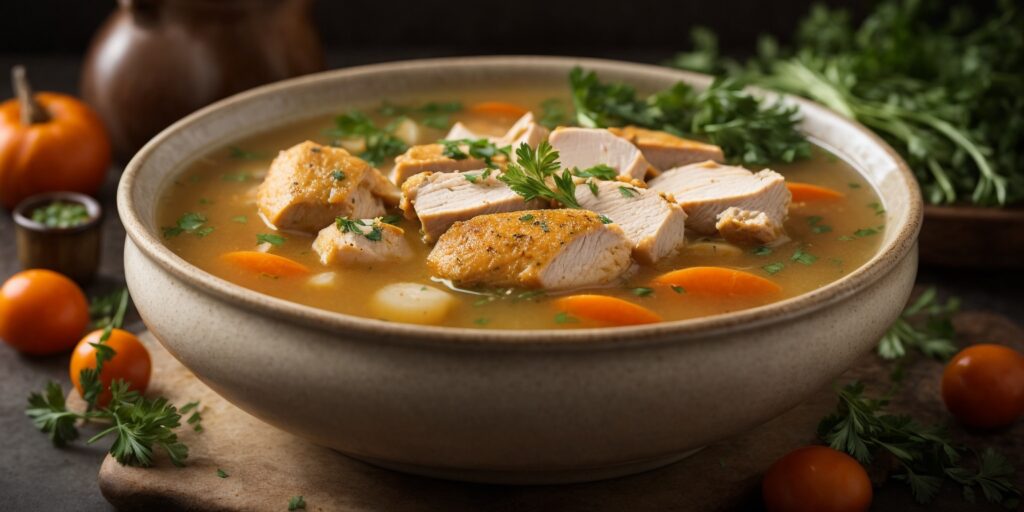
Ingredients:
- 2-3 pounds of chicken bones
- 2 carrots, chopped
- 2 celery stalks, chopped
- 1 onion, chopped
- 4 cloves of garlic, smashed
- 2 bay leaves
- 1 tablespoon of apple cider vinegar
- Salt and pepper to taste
Instructions:
- Place all ingredients in a large pot and cover with water.
- Bring to a boil, then reduce heat and let simmer for 6-8 hours.
- Strain the broth and discard the solids.
- Season with salt and pepper to taste.
Variation Tips:
- Add fresh herbs like thyme or rosemary for an extra flavor boost.
- Roast the chicken bones in the oven before simmering for a deeper, richer flavor.
- Use a slow cooker for convenience, cooking on low for 8-10 hours.
Beef Bone Broth
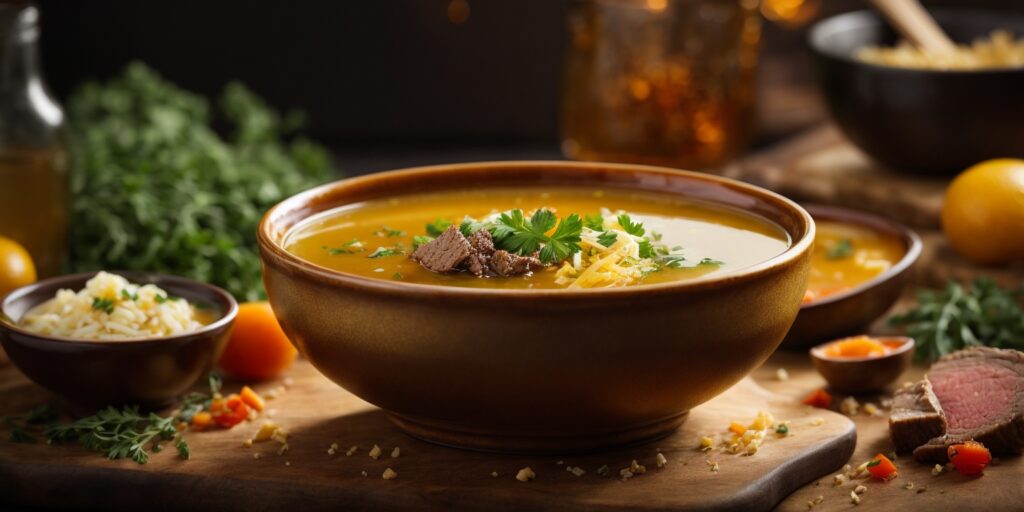
Ingredients:
- 3-4 pounds of beef bones
- 1 onion, chopped
- 3 carrots, chopped
- 3 celery stalks, chopped
- 4 cloves of garlic, smashed
- 2 bay leaves
- 1 tablespoon of apple cider vinegar
- Salt and pepper to taste
Instructions:
- Preheat the oven to 400°F and roast the beef bones for 30 minutes.
- Place the roasted bones in a large pot with the vegetables and cover with water.
- Add the apple cider vinegar and bay leaves.
- Simmer for 12-24 hours, skimming off any foam that rises to the top.
Variation Tips:
- Add a splash of red wine for a depth of flavor.
- Throw in some mushrooms for an earthy undertone.
- Use a pressure cooker for a quicker cooking time, around 3 hours.
Fish Bone Broth
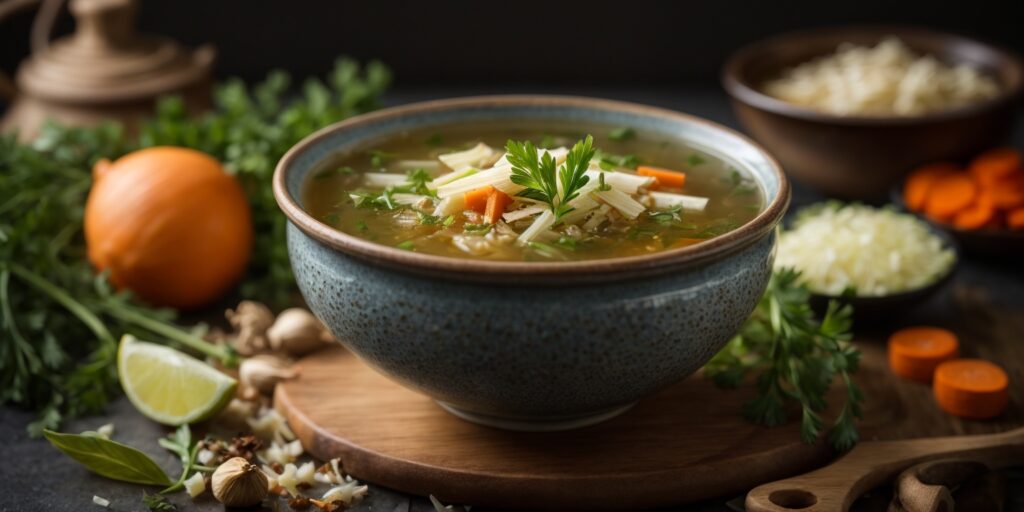
Ingredients:
- 2 pounds of fish bones (such as halibut or cod)
- 1 onion, chopped
- 2 carrots, chopped
- 2 celery stalks, chopped
- 4 cloves of garlic, smashed
- 2 bay leaves
- Salt and pepper to taste
Instructions:
- In a large pot, combine the fish bones, vegetables, garlic, and bay leaves.
- Cover with water and bring to a gentle simmer.
- Let the broth simmer for 2-3 hours, skimming off any impurities that rise to the surface.
- Season with salt and pepper to taste before straining the broth.
Variation Tips:
- Add a splash of white wine for a touch of acidity.
- Incorporate lemongrass and ginger for a fragrant and flavorful twist.
- For a more intense flavor, roast the fish bones in the oven before simmering.
Turkey Bone Broth
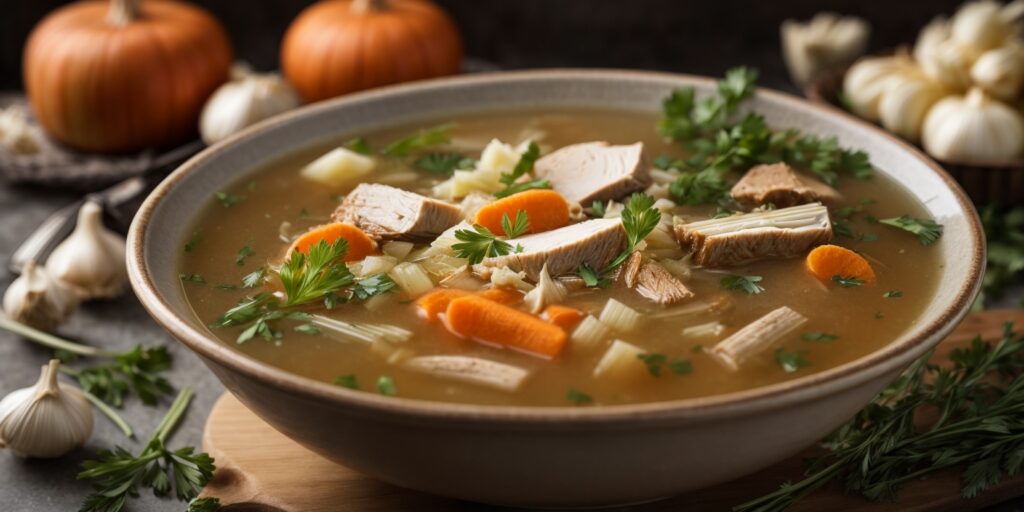
Ingredients:
- 2-3 pounds of turkey bones
- 2 carrots, chopped
- 2 celery stalks, chopped
- 1 onion, chopped
- 4 cloves of garlic, smashed
- 2 bay leaves
- 1 tablespoon of apple cider vinegar
- Salt and pepper to taste
Instructions:
- Place all ingredients in a large pot and cover with water.
- Bring to a boil, then reduce heat and let simmer for 6-8 hours.
- Strain the broth and discard the solids.
- Season with salt and pepper to taste.
Variation Tips:
- Add a sprig of fresh sage for a savory, aromatic flavor.
- Use leftover turkey bones from a holiday meal for a budget-friendly option.
Vegetable Bone Broth
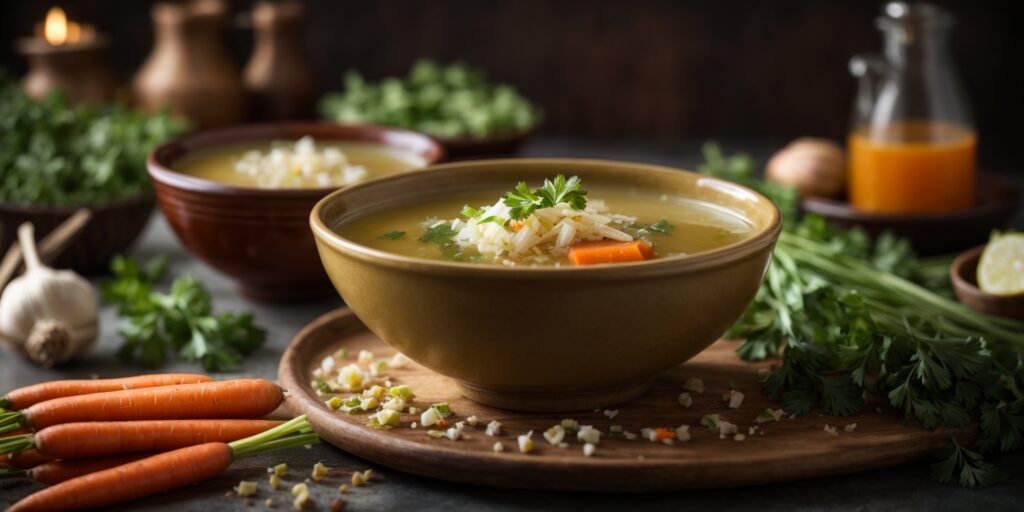
Ingredients:
- 1 onion, chopped
- 3 carrots, chopped
- 3 celery stalks, chopped
- 1 leek, chopped
- 4 cloves of garlic, smashed
- 2 bay leaves
- 1 tablespoon of apple cider vinegar
- Salt and pepper to taste
Instructions:
- In a large pot, combine all the vegetables, garlic, bay leaves, and apple cider vinegar.
- Cover with water and bring to a gentle simmer.
- Let the broth simmer for 4-6 hours, allowing the flavors to meld.
- Season with salt and pepper to taste before straining the broth.
Variation Tips:
- Add a handful of dried mushrooms for a rich, umami flavor.
- Throw in some fresh parsley and thyme for a burst of herbaceousness.
Selecting the Best Bones for Flavorful Broth
Emphasizing High-Quality Bones
When making easy bone broth recipes, it’s crucial to prioritize using high-quality broth bones. Opt for bones from grass-fed animals as they tend to yield a richer and more flavorful broth. These bones are generally free from antibiotics and hormones, ensuring a healthier and tastier end product.
It’s also beneficial to source your beef bones or other animal bones from a trusted local butcher. This ensures that you’re getting fresh, high-quality bones that will greatly enhance the overall flavor of your broth.
Exploring Different Types of Bones
For a diverse range of flavors in your bone broth, consider utilizing various types of bones such as pork bones, roasted beef bones, fishbones, or even the remains of a rotisserie chicken like the chicken carcass. Each type of soup brings its own unique essence to the recipe and can cater to different culinary preferences.
Experiment with combining different types of bones – perhaps mixing beef bone marrow-rich pieces with neck or short ribs – to create complex layers of taste in your homemade bone broth.
Benefits of Using Marrow-Rich Bones
Marrow-rich beef bone contains essential nutrients like collagen and amino acids which contribute significantly to the health benefits associated with consuming bone broth. The bone marrow adds richness and depth to the meat while also imparting valuable nutrients into the soup.
Incorporating bones and water into your easy bone broth recipes not only enhances the taste but also provides potential health advantages for those enjoying this nourishing soup.
Essential Ingredients for Homemade Bone Broth
Key Ingredients
To create easy bone broth recipes, you’ll need a few essential ingredients like bones and chicken. Start with filtered water, which serves as the base of your broth. Next, add a splash of vinegar and water to help extract valuable minerals from the bones. Then, gather an assortment of aromatics like onions, garlic, herbs, and chicken to enhance the flavor profile.
Using quality organic vegetables and herbs is crucial in making flavorful homemade bone broth./// For instance, adding chopped onions can impart a sweet depth to the soup, while garlic brings its unique savory notes. Incorporating bay leaves not only contributes subtle earthy tones but also infuses the soup with aromatic richness.
Significance of Organic Ingredients
Opting for organic ingredients when preparing your homemade bone broth recipe ensures that you’re using ///. This means that your final product will be free from potentially harmful chemicals commonly found in non-organic foods.
Bone Broth Making Methods: Stove, Instant Pot, and Crock Pot
Time and Convenience
The cooking method you choose plays a significant role in the time and effort required. The traditional stove-top method involves constant monitoring and can take up to 24 hours. Using an Instant Pot or Crock Pot significantly reduces hands-on time. For example, bone broth made in an Instant Pot only takes about two hours compared to a whole day on the stove.
The convenience of each method is also worth considering. While the stove-top method demands regular supervision throughout the simmering process, both the Instant Pot and Crock Pot allow for “set it and forget it” convenience. This means you can start your bone broth recipe and attend to other tasks without worrying about constantly checking on it.
Pros and Cons
Each cooking method has its own set of advantages and disadvantages. For instance, while making bone broth on a stovetop allows for better control over temperature adjustments during different stages of boiling, using an Instant Pot guarantees consistent pressure-cooking results every time. Similarly, although a slow cooker like a Crock Pot offers convenience by allowing longer unattended cook times with minimal evaporation loss due to its tight-fitting lid, it may not achieve as rich a flavor profile as that produced through traditional simmering methods.
- Traditional Stove-Top Method:
- Pros:
- Better control over temperature adjustments.
- Intensified flavor due to prolonged simmering.
- Cons:
- Requires constant monitoring.
- Lengthy cooking duration.
- Modern Techniques (Instant Pot & Crockpot):
- Pros:
- Reduced hands-on time.
- Set-it-and-forget-it convenience.
- Cons:
- Limited control over temperature adjustments.
- Less intensified flavor compared to the traditional stove-top method.
- Longer cooking times for certain dishes.
Tips for Perfect Bone Broth Every Time
Simmering Time
When making easy bone broth recipes, the simmering time and bones are crucial for extracting rich flavor. Cooking the recipe in a pot for longer simmering allows the chicken bones to release more nutrients and minerals, enhancing the overall taste of the broth. A slow and steady simmer over several hours in a pot ensures that all the goodness from the chicken bones is fully extracted into the liquid, resulting in a flavorful and nutritious broth.
For example:
- Simmering beef bones in a pot for at least 12 hours can yield a deeply flavorful and nutrient-dense broth.
- The chicken bones benefit from a minimum of 8 hours of simmering in a pot to produce a well-rounded and savory broth.
Skimming and Straining
Skimming off impurities that rise to the surface while cooking chicken bones is essential for achieving clarity in your bone broth. This process helps remove any foam or excess fat from chicken bones, resulting in a clear, clean-looking broth. Straining the finished chicken broth through a fine-mesh sieve or cheesecloth removes any remaining particles or sediment, ensuring a smooth texture.
For instance:
- Skim off foam periodically while cooking to maintain clarity.
- Use a fine-mesh sieve lined with cheesecloth when straining for an ultra-smooth consistency.
Proper Seasoning
Proper seasoning plays an important role in elevating the flavor profile of your bone broth. Adding salt towards the end of cooking enhances the overall taste without overpowering it. It’s essential to season cautiously as you can always add more salt later if needed but cannot take it away once it’s added.
Flavor Enhancements and Customization Options
Various Flavor Additions
When making easy chicken bone broth recipes, consider adding flavor enhancements like ginger, turmeric, or miso. These ingredients not only contribute to the taste but also offer additional health benefits. For instance, ginger adds a warm and spicy kick, while turmeric brings a slightly bitter flavor with its vibrant yellow hue.
Customization Based on Preferences The beauty of creating your own bone broth lies in the ability to customize it based on personal preferences. If you prefer a fruitier taste, consider adding a slice of lemon or orange peel during the simmering process. Alternatively, if you enjoy anise-like flavors, experimenting with star anise can elevate the overall taste profile.
Use of Spices and Herbs
Spices and herbs play a crucial role in elevating the depth of flavor in easy bone broth recipes. Adding spices such as cinnamon or cloves can impart warmth and complexity to the chicken broth. Furthermore, incorporating fresh herbs like thyme or rosemary can infuse a refreshing aroma that enhances both the smell and taste of your homemade bone broth.
Incorporating Bone Broth into Daily Meals
Versatile Cooking Ingredient
Bone broth is a versatile ingredient that can be used in various ways to enhance the flavors of your meals. You can incorporate beef bone broth and bones into soups, stews, and sauces to add depth and richness to the dishes. For example, when making a hearty beef stew, replace regular broth with bone broth for an added nutritional boost. The collagen-rich chicken liquid adds a savory element to the dish while providing essential nutrients.
Bone broth is perfect for cooking grains and legumes. When preparing rice or quinoa, substitute water with beef bone broth to infuse the grains with extra flavor. The result is a more robust taste that complements a wide range of main courses. Using chicken bone broth in cooking vegetables like carrots and celery elevates their natural sweetness and enhances their overall taste profile.
Standalone Beverage Option
Apart from being an excellent addition to various recipes, bone broth also has potential as a standalone beverage option. By incorporating it into your daily routine, you can enjoy its numerous health benefits conveniently. Whether consumed on its own or as part of intermittent fasting practices, sipping on warm chicken bone broths provides nourishment while promoting satiety.
Moreover, beef bone broth, made from grass-fed beef bones simmered over several days with sea salt and organ meats if desired, offers high-quality protein along with essential minerals such as calcium and magnesium.
Storing and Reheating Your Homemade Bone Broth
Proper Storage
It’s crucial to maintain its freshness. After cooking, allow the broth to cool at room temperature before refrigerating or freezing. For short-term storage, keep it in the refrigerator for up to 4-5 days. If you plan to use chicken later, store it in the freezer using airtight containers or ice cube trays for easy portioning.
To extend chicken broth shelf life, consider freezing the broth by pouring it into labeled zip-top bags or small containers. Another option is freezing in ice cube trays; once frozen, transfer them into a resealable bag for quick access when needed.
Safe Reheating Methods
When reheating your bone broth, avoid high heat as this can degrade nutrients and alter flavor. Instead, gently warm over low heat on the stove until thawed if frozen or heated through if refrigerated. You can also use a microwave-safe dish and reheat chicken in short intervals at medium power.
Refrain from boiling chicken bones as this may compromise some of the nutritional benefits of the bone broth. Always ensure that chicken reaches a safe temperature before consuming.
Understanding the Health Benefits of Regular Consumption
Nutritional Value of Bone Broth
Bone broth is packed with essential nutrients, including collagen and various minerals. Collagen supports bones, skin elasticity, and joint health, while the minerals contribute to overall well-being.
Bone broth’s high collagen content from bones can aid in joint support, promoting flexibility and reducing discomfort. The presence of vital minerals like calcium and magnesium helps maintain healthy bones.
Potential Health Benefits
Regular consumption of bone broth can benefit your digestive system, potentially reducing digestive problems such as bloating or discomfort. The gelatin found in bones may help soothe and heal the gut lining.
Moreover, bone broth contains amino acids that support a healthy immune system. These nutrients work to strengthen your body’s defense mechanisms against common illnesses.
Conclusion on Mastering Easy Bone Broth Recipes
You’ve now mastered the art of creating delicious and nutritious bone broth. With the right ingredients, cooking methods, and storage techniques, you can enjoy this wholesome elixir as a standalone beverage or incorporate it into various recipes to elevate its flavor and nutritional value. Embrace the health benefits of bone broth in your daily routine and savor the satisfaction of creating a homemade staple that nourishes both body and soul.
Start experimenting with different flavors, spices, and uses for your bone broth. Share your newfound knowledge with friends and family, and continue exploring the world of homemade culinary delights. Keep honing your skills, and remember that every batch of bone broth is an opportunity to refine your craft and treat yourself to a warm, comforting experience. /// Cheers to your culinary journey!
Frequently Asked Questions
How can I select the best bones for flavorful broth?
When selecting bones for bone broth, opt for a mix of marrow-rich and meaty bones. Look for grass-fed or organic options to enhance flavor and nutritional value. /// Beef knuckle, oxtail, and chicken backs are excellent choices.
What are some essential ingredients for homemade bone broth?
Essential ingredients include bones (chicken, beef, or fish), water, apple cider vinegar (for extracting minerals), vegetables like onions and carrots, and herbs such as parsley and bay leaves.
What are some tips for achieving perfect bone broth every time?
Maintain a low simmer when cooking the broth to avoid cloudiness. /// Skim off any foam that rises to the top during the initial stages of cooking. Using high-quality ingredients is key to achieving a delicious result.
How can I incorporate bone broth into daily meals?
Bone broth can be used as a base for soups, stews, sauces, or simply enjoyed on its own with added seasonings. It’s also great in risottos or substituted in place of water when cooking grains like rice or quinoa.
What are some flavor enhancements and customization options for bone broth?
You can customize your bone broth by adding aromatics like garlic or ginger during the simmering process. Season with salt towards the end of cooking along with other spices like turmeric or cayenne pepper to suit your taste preferences.

